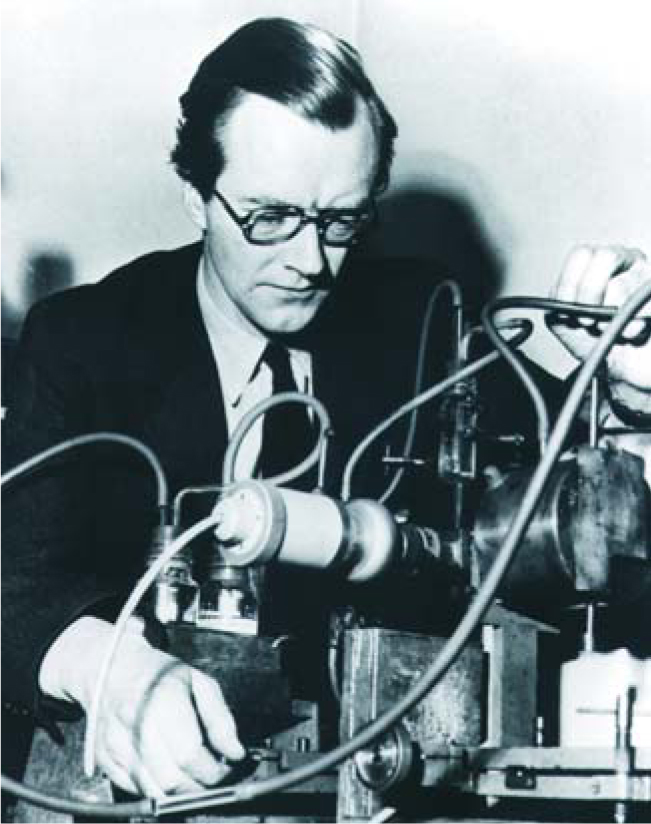Maurice Hugh Frederick Wilkins
DOI: 10.1063/1.2117833
Maurice Hugh Frederick Wilkins, awarded the 1962 Nobel Prize in Medicine with Francis Crick and James Watson for “their discoveries concerning the molecular structure of nucleic acids and its significance for information transfer in living material,” died in London on 5 October 2004.
Born in Pongaroa, New Zealand, on 15 December 1916, Wilkins was six years old when the family moved to Birmingham, England. He attended the local schools and later won a scholarship to Cambridge University, where he graduated with a degree in physics. From there he went to the University of Birmingham and began a long relationship with John Randall, who supervised Wilkins’s PhD research on luminescence in crystals.
After spending World War II working first in Birmingham on radar and then in Ernest Lawrence’s laboratory in Berkeley, California, on research related to the Manhattan Project, he accepted a lectureship at the University of St. Andrews in Scotland, where Randall was reorienting the physics department to attack biological problems. In 1946, Randall moved to King’s College at the University of London as head of the department of physics and director of the newly formed Medical Research Council Bio-physics Research Unit. Randall invited Wilkins to join him at the unit.
Wilkins was stimulated to work on biological problems by reading Erwin Schrödinger’s What Is Life? (University Press and Macmillan, 1944). The speculations of one of the great physicists of the 20th century on the central problem of biology encouraged Wilkins to direct his research to microscopic studies of cells, and in particular the DNA content of those cells. That research led to his work on the structure of DNA itself and to the application of x-ray diffraction techniques.
At the time, most DNA was prepared by methods that produced small fragments of the molecules; those fragments were difficult to align into fibers and yielded poor x-ray data. However, Rudolf Signer of the University of Bern in Switzerland used gentler techniques to prepare much less degraded DNA, and in 1950 he made his invaluable material available to researchers. One of the fortunate recipients was Wilkins. With graduate student Raymond Gosling, he obtained x-ray patterns that showed unmistakable evidence of microcrystallinity. For the first time, it was clear that DNA had a regular, and potentially solvable, structure.
Watson, well aware of the central importance of DNA, first saw these photographs when Wilkins gave a talk at a conference in Naples, Italy, in early 1951. In The Double Helix (Atheneum, 1968), Watson writes, “Before Maurice’s talk I had worried about the possibility that the gene might be fantastically irregular. Now, however, I knew that genes could crystallize; hence they must have a regular structure that could be solved in a straightforward fashion.” Not only did the diffraction photographs show crystallinity, but the pattern showed blank areas on the meridian parallel to the fiber axis. Wilkins’s colleague, Alex Stokes, an expert on image formation and Fourier transforms, calculated the Fourier transform of a helical structure and derived the now-classic Bessel-function distribution of intensities, with a meridional blank area consistent with a helical structure.
Rosalind Franklin came to King’s College later in 1951, expecting to work on solution structures of proteins using x-ray diffraction. When she arrived, Randall asked her to work on DNA. He not only assigned her to that task but also gave her sole access to the high-quality DNA that Wilkins had received from Signer, and transferred Gosling to her. Wilkins was away when those assignments were made, and the resulting misunderstanding was one of the major sources of the rift between Wilkins and Franklin. Joined by a new x-ray diffraction expert, Herbert Wilson (who obtained what are still some of the best DNA x-ray diffraction photographs), Wilkins continued his research, only to see the now-classic double-helix model of DNA constructed by Watson and Crick.
The story about the discovery of the structure of DNA has been told many times, nowhere more grippingly than in Watson’s The Double Helix. A paper by Wilkins, Stokes, and Wilson, and one by Franklin and Gosling, immediately followed the Watson and Crick Nature paper in 1953. It is probable that Wilkins and Franklin would eventually have solved the structure if Watson and Crick had not. Between them, they had all the parts of the puzzle. If only they had communicated with each other as well as Watson and Crick did, the outcome might have been different.
The Watson–Crick model of DNA was clearly correct in general, but it did not fit the detailed x-ray diffraction data. With better preparations of DNA and improved computer methods, the Wilkins group spent several years refining DNA models, while Wilkins extended his research interests to membrane structure. He and his wife Pat also devoted much time to organizations such as the Campaign for Nuclear Disarmament. As he remarked, having the Nobel Prize helped.
Wilkins enjoyed working in the laboratory, even the time-consuming and painstaking process of drawing well-oriented DNA fibers. The accompanying photograph shows him with an x-ray generator, x-ray cameras, and camera mounts. He designed the cameras, with their 100-μm adjustable collimators, and the kinematic mounts. Those mounts made the tedious process of camera alignment much simpler and more reproducible than with the crude commercial systems.
Franklin’s premature death in 1958 robbed science of one of its best, but some later writers found it necessary to rewrite history and to demonize Wilkins. That caused him considerable pain, and his autobiography, The Third Man of the Double Helix (Oxford U. Press, 2003), was an attempt to correct some of those misrepresentations. As a graduate student in his laboratory, I saw Wilkins almost every working day from 1954 until my departure in 1957. The sense of his quiet and unassuming personality that pervades the book is an accurate reflection of the man.

KING’S COLLEGE LONDON

More about the Authors
Robert Langridge. Berkeley, California, US .
